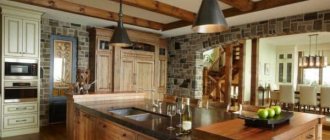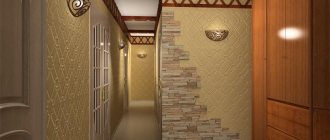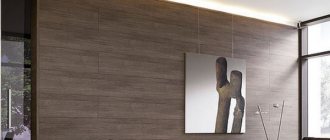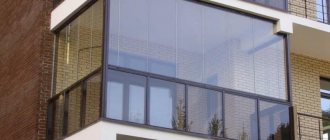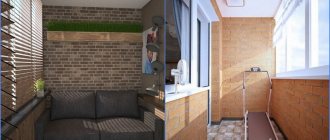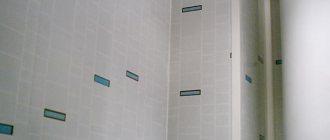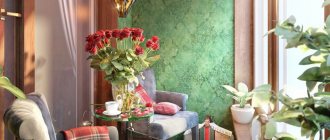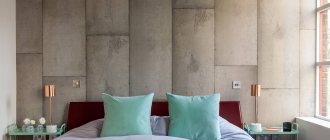Wall painting options
There are two completely different options for painting a balcony, internal and external. These different types of work have completely different requirements.
Painting the inside of the balcony is the most important thing disguise as best as possible .
Of all the variety of ways to decorate walls on balconies, painting stands out precisely because it is the least labor-intensive and simplest method of decoration. This process consists of several steps that are absolutely simple:
- preparing the wall surface on which paint will be applied;
- primer of the prepared surface;
- The final stage is applying paint to the wall.
If you decide to paint the brick walls on your balcony or loggia, then know that this is a very interesting decor option.
The walls can be given various unique shades and at the same time hide minor imperfections in the brickwork.
If you compare painting a brick wall with other finishing works, it is obvious that painting is much cheaper and easier to work with than plastering or, for example, cladding.
However, we must not forget that painting the walls will require you to carefully prepare its surface; if you do not carry out such preparation, then all the flaws , irregularities will be obvious, and not a single paint coating will be able to hide the defects.
How to paint a balcony
The most popular paints for this purpose are water-based acrylic paints. They are non-toxic, do not emit a pungent odor, are not flammable, and are resistant to moisture. The drying time of the paint is from 2 to 24 hours. When working with acrylic paint, you will not disrupt your usual home order. Acrylic paints are easy to thin, which is a significant plus, since different application methods (paint roller, brush, spray) will require different degrees of viscosity. Paint consumption will be 150 – 200 ml per square meter. meter if applied in one layer.
Stores usually sell a white or colorless tone; You can give it the desired shade yourself by selecting the appropriate color pigments and dissolving them in a container with a coloring composition. Acrylic paints are considered very durable; they retain their properties on wood for up to 8 years, and on plaster – even up to 20 years. But such record-breaking results are only possible with proper preparation of the base - the brick wall. It is also important to take into account that despite the fact that acrylic paint dries in a short time, the final hardening of the film occurs within a month. Therefore, the newly painted surface must be protected from rough mechanical influences and contamination.
READ MORE: Installing a latch on a balcony door
Alkyd paints are enamels in their composition and properties. They quickly form a reliable coating and can withstand any load within a few days. But in terms of strength they are significantly inferior to acrylic ones. Within a year they become dull and covered with cracks. Painting the walls on your balcony with an alkyd compound is accompanied by a pungent odor and harmful fumes. The main advantage of this type of paint is its decorative qualities, a wide selection of bright and rich colors.
Oil paints, known and widespread due to their low price, are also used for painting brick on the balcony. They do not emit such a pungent odor as alkyd ones. They have reliable adhesion to the surface, are good protection against moisture, and can serve for a long time if they are not subject to abrasion. But they apply worse than acrylic ones and have low hiding power, that is, the ability to cover the color of the base. In addition, they fade in the sun, which means they are inappropriate on a sunny balcony. Often used as a primer.
Having decided how to paint a brick wall, you should stock up on the necessary working tools in advance: purchase a paint roller or sprayer, spatula, paint containers, masking (crepe) tape, solvent. Even if the balcony is painted with a roller, you will need brushes 6–8 cm wide to paint the corners.
Paint selection
When purchasing materials, pay attention to water-based paint for exterior use, which is most suitable for this work.
A brick coated with a layer of oil paint does not breathe, and this leads to its gradual destruction due to increased moisture permeability.
There is a very large selection on the finishing materials market and you need to know that water-based paints are sold only white . In the case when it is necessary to give them a different color, it is necessary to add color , that is, a special additive to give a different color or any shade.
Contact the sellers for help and they will help you choose the shade you like using a tinting card. By adding color to the paint and mixing it thoroughly, you can directly with your hands, due to the absolute non-toxicity of the drug, we get the desired color.
Choosing the right paint
Color is not the main parameter that you need to rely on when decorating a balcony and choosing paint. Which shade should I choose? This is a secondary question; everything here depends entirely on the taste of the owners.
The main thing is to choose the right type of paint.
On the balcony it is best to use water-based paint, which is often used for exterior work. The fact is that such a coating has the necessary structure and durability.
But there is no need to choose oil paint - the brick underneath will not receive air and release moisture, which is why after a short time you will notice cracks and peeling on the walls.
You also need to know that despite the huge selection of manufacturing companies, water-based paint is only white.
Video:
To change the color, you need to add a special color - an additive that is mixed with the main paint. This approach allows you to obtain different shades with different intensities.
You can also choose acrylate paints, because they are highly wear-resistant but easy to maintain. Their only drawback is their rather high price.
Preparatory stage
It involves very careful work with a spatula and a wire brush in order to remove all dirt and unevenness.
Cracks and holes that may be in the wall must be filled with putty.
Then you choose coarse sandpaper and work the surface very carefully, subsequently sanding it. The seams between the bricks can be puttied if you want a smooth surface.
Pay attention to the quality of the brick from which the wall is laid and the quality of the masonry.
carefully for surface damage. If the surface of the wall is in good condition, in the case when the brickwork is smooth and well executed, then it should not be plastered, but it would be more interesting to use it as a certain structure that will look interesting and decorate your balcony.
Primer of the prepared surface
In the event that there is mold , these places must be treated an alkaline solution, which will not take you much time and will not complicate you, then use an acrylic primer with antibacterial components for priming.
To protect an antibacterial primer for such outdoor work . Using a roller and a brush, you need to carefully prime the wall, including all the seams between the bricks.
In the case when you want to restore the paintwork. The wall must be very carefully cleaned of old paint.
Procedure for painting
Painting a brick wall on a loggia requires careful pre-treatment of the surface to be painted in several stages:
- It would be a good idea to clean the wall of dust and dirt and treat it with a special antiseptic solution that protects against mold. Be sure to remove traces of old paint, if any.
- All uneven walls and brickwork seams must be puttied. But first, brush the seams with a stiff wire brush. The voids discovered in this case are carefully sealed, but so that the seams do not protrude above the surface of the masonry. This must be done carefully so as not to stain the brick with putty. You can use masking tape.
- Then they begin to prime the brick wall; this operation will significantly improve the adhesion of the paint to the surface. You will get an ideal surface if you walk over the wall with a vacuum cleaner brush before priming. Otherwise, small lumps will form under the primer; they will remain noticeable even under the paint layer. The brand of putty and primer must match the paint chosen for the balcony. Once the primer has dried, you can begin painting.
- It is better to apply the paint in several layers to achieve uniform coloring. Using a roller or wide brush, paint for the balcony is applied from bottom to top and back. The second way is to alternately change the movement of the brush from vertical to horizontal. Each new layer is applied to the previous one only after it has completely dried. Recesses in the seams and corners are painted with a paneled brush. If the walls are large, it is better to use a sprayer.
READ MORE: How and with what to raise the floor level on the balcony
Applying paint to the wall
It is possible to carry out painting work only after completely dried with a brush or roller.
You will be faced with a simple task that will not be difficult for you to cope with. Properly selected wall paint is a guarantee that you will not be disappointed with the result of your work on painting the wall on the balcony, and you should choose it based on the following criteria:
- there is a wall inside or outside the room;
- quality of brickwork with a large or small number of defects;
- certain requirements arising for the coating for painting
If the balcony is not glazed and the wall is located in an open street space, use facade paint for masonry. In this case, any professional will advise you on elastomeric paint, which is expensive and difficult to apply, but the effect of its use will exceed your expectations.
It will perfectly cope with cracks on the wall, completely cover them and protect the wall from moisture , perfectly withstanding various changes thanks to its thick layer, which is thicker than any other paint.
Painting walls on an insulated balcony should not water-repellent or frost-resistant. And it can be acrylic, silicate or any polymer paint.
Among the tools for this work, you will need a roller; it is most convenient to use a wide roller and a paint brush , with which you will apply paint in hard-to-reach places, and most importantly, patience and attention.
It is best to apply the coating by spray.
If you take into account all the above tips, are very careful , choose materials and choose a color scheme, then this type of finishing you have chosen will not disappoint you and will give your balcony a modern and very attractive look that you will enjoy for many years.
Show your design skills, patience, without spending a lot of time and effort, and you will be proud of the results you get in the form of a comfortable, cozy balcony.
Methods for painting a balcony wall
You can paint a wall in one of two ways - leaving the brick texture unchanged or leveling the wall with a layer of plaster and then painting it. The first method can only be used if the brickwork does not have serious defects. The second method can be used if the wall needs serious repairs or the “brick” design does not correspond to the overall style of the interior.
Balcony with painted brick wall
Painting a wall without leveling it with plaster
This method is simpler, but to prevent the paint from crumbling and swelling over time, it requires careful preparation of the surface, which includes several steps:
- Surface cleaning;
- Seam alignment;
- Wall primer.
Painting a brick wall without plaster
The brickwork is cleaned of dust, dirt and mortar, and if the brick has already been painted, the previous layer of paint must also be cleaned off. If this is not done, repainting may pull the old paint and cause it to peel off the surface. The seams are cleaned with a stiff brush, and the voids identified during the cleaning process are filled with mortar. This must be done with care so that the seams are filled evenly and they do not differ from the general background, and also trying not to stain the brick.
Now the wall needs to be primed - this will promote better adhesion of the paint to the brick. The choice of primer depends on what type of paint you will be using.
Immediately before priming the wall, clean it again with a vacuum cleaner to remove dust. This way you can avoid the formation of small lumps that appear during the application of the primer and then clearly stand out under the paint layer.
Painting a brick wall on a loggia or balcony should begin only after the primer has dried. We recommend doing this with a brush, which allows you to better paint corners, small protrusions and grooves in seams. A paneled brush 6-8 cm wide is suitable - it fits freely into the grooves of the seams and evenly distributes the paint over the surface of the brick. A roller or sprayer can be used if the balcony walls have a large area.
Painting balcony walls with pre-plaster
If you decide to paint a brick wall on a balcony using this method, the whole process will take longer because it includes the following steps:
- Surface cleaning;
- Plastering;
- Putty;
- Primer.
Paint the brick white
The surface is cleaned of dust, dirt and loose formations, and a layer of plaster is applied to it. If the loggia is not heated in winter or the outer wall needs to be painted, prepare a cement-sand mortar. For closed heated balconies, it is permissible to plaster with gypsum mixtures without adding cement. Using a layer of putty applied to the plaster, you can achieve a perfectly smooth surface, and this is especially true for the interior decoration of a loggia used as a living space.
For external walls or unglazed balconies, you can skip the stage of puttying the walls, since under the influence of temperature changes and moisture, the putty will peel off and the walls will need to be repaired more often.
After drying, the wall can be primed and painted. It is better to paint with a roller or spray, after covering the windows and floor with plastic film.
Options for installing decorative bricks
This process is carried out using two methods:
- Installation with seams. This is a troublesome option, but the final result is pleasing to the eye, as it looks like finishing with natural stone. The presence of seams allows you to hide unevenness that arose during installation. You can adjust the gap between the tiles using special spacers, which can vary from 0.5 mm to 1 cm.
- Laying without seams. The method is more complex and requires care, because it is necessary to ensure that no glue remains on the surface of the finishing material. Removing the glue from the tile surface will then be quite problematic. For more information on how to glue decorative gypsum bricks, watch this video:
Related article: Grouting drywall joints: materials and techniques for performing the work
